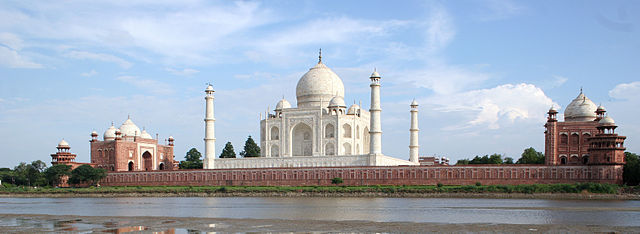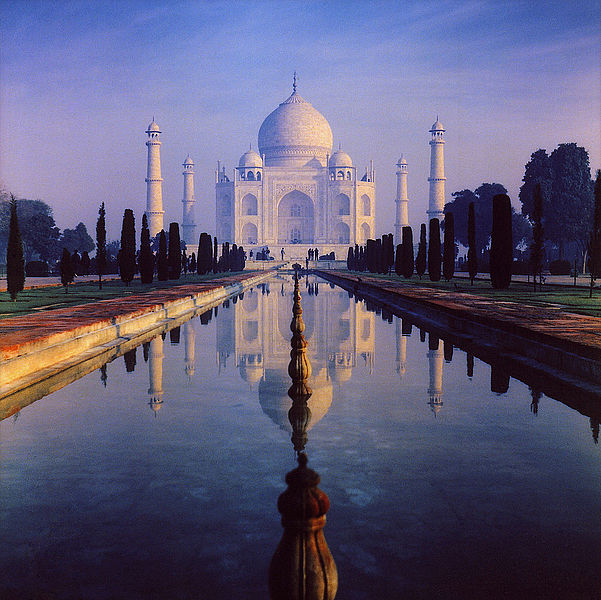"Going green with envy" is a common phrase meaning that a person has become consumed with jealousy.
"Going green with bug poop" is, well, it's not a phrase at all, really. But it's safe to say that no one and nothing is jealous of the Taj Mahal right now. That's because the legendary Indian monument is slowly getting covered in the excrement of millions of insects, and the overall effect is that its walls are turning green.
And we're not talking a subtle, tasteful mint green either. Just look...
Taj Mahal goes green, but not in a good way https://t.co/iGf0hcFMFl #pollution #Yamuna pic.twitter.com/AjWDP3Eaiu
— Sribala Subramanian (@bsubram) May 18, 2016
The sharply dark green hue comes from the feces of Goeldichironomus, a mosquito-like fly that is breeding in swarms in the Yamuna river, which flows near the Taj Mahal. The Yamuna is both heavily polluted and suffering from a drought. The fish that once lived there are gone. All that is left behind is putrid, brackish (very salty) water. And algae. The flies love this and their population is blooming.
Attractive to humans and flies alike

The Yamuna river runs, which alongside the Taj Mahal, has now become a breeding ground for the Goeldichironomus fly. (Wikimedia Commons)
People have been flocking to the Taj Mahal for centuries. Built in the early 1600s by the emperor Shah Jahan, it has been described by many as the most beautiful building in the world, and a jewel of Muslim architecture. Not only does the massive white marble structure boast endless gorgeous art and carvings inside and out, but its overall symmetry (that's the way its left and right side are in balance) and long reflecting pool make it a one-of-a-kind sight. It's so impressive that about 8 million people visit it every year.
Sadly, the flies also find it striking, though their reasons are a little more plain. Simply put, the shiny white marble is very attractive to them. It attracts them a little like how a moth is drawn to a bright light. This means that swarms of them land and eventually poop on the centuries-old treasure. In case you're wondering, yes, they can wash the poop off. But doing so requires a lot of scrubbing, and that can quickly damage the delicate floral patterns that cover its walls.
 The Taj Mahal and its reflecting pool are considered one of the world's most beautiful manmade sights. (Wikimedia Commons)
The Taj Mahal and its reflecting pool are considered one of the world's most beautiful manmade sights. (Wikimedia Commons)










Ewwwwwwwww!
ahhhhhhhhhhhhhhhhhhhhhhhhhhhhhhhhhhhhhhhhhhhhhhhhhhhhhhhhhhhhhhhhhhhhhhhhhhhhhhhhhhhhhhhhhhhhhhhhhhhhhhhhhhhhhhhhhhhhhhhhhhhhhhhhhhhhhhhhhhhhhhhhhhhhhhhhhhhhhhhhhhhhhhhhhhhhhhhhhhhhhhhhhhhhhhhhhhhhhhhhhhhhhhhhhhhhhhhhhhhhhhhhhhhhhhhhhhhhhhhhhhhhhhhhhhhhhhhhhhhhhhhhhhhhhhhhhhhhhhhhhhhhhhhhhhhhhhhhhhhhhhhhhhhhhhhhhhhhhhhhhhhhhhhhhhhhhhhhhhhhhhhhhhhhhhhhhhhhhhhhhhhhhhhhhhhhhhhhhhhhhhhhhhhhhhhhhhhhhhhhhhhhhhhhhhhhhhhhhhhhhhhhhhhhhhhhhhhhhhhhhhhhhhhhhhhhhhhhhhhhhhhhhhhhhhhhhhhhhhhhhhhhhhhhhhhhhhhhhhhhhhhhhhhhhhhhhhhhhhhhhhhhhhhhhhhhhhhhhhhhhhhhhhhhhhhhhhhhhhhhhhhhhhhhhhhhhhhhhhhhhhhhhhhhhhhhhhhhhhhhhhhhhhhhhhhhhhhhhhhhhhhhhhhhhhhhhhhhhhhhhhhhhhhhhhhhhh